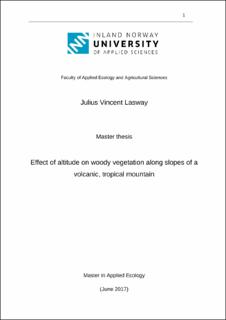| dc.description.abstract | This study was initiated to investigate the effects of altitude on woody vegetation on the eastern slopes of Mount Meru, Tanzania. Changes in vegetation along altitudinal gradients are related to climate factors, soil quality and biotic factors. Changes in vegetation composition may or may not correspond with changes in species richness and diversity. Altitude may also affect woody plant structure, such as tree height and canopy cover. Based on studies from other East African mountains, I hypothesized that community composition of woody plants changes distinctly with altitude. I also hypothesized that species richness and diversity of woody plants, canopy cover and tree height decrease with altitude. To test these hypotheses, I carried out a detailed vegetation survey in 44 plots of 10 meters by 10 meters, located in five transects ranging from 1600 to 3400 meters above sea level along the eastern slope of Mount Meru in Arusha National Park, Tanzania. I measured species abundance, tree height and canopy cover. I then analyzed changes in woody vegetation community composition, species richness, diversity, height and canopy cover in relation to altitude using multivariate analysis, and linear and generalized linear models. Woody community vegetation composition changed distinctly with altitude. I identified three vegetation communities or vegetation zones; Bersama abyssinica-Vepris simplicifolia, Hagenia abyssinica-Hypericum revolutum and Erica arborea. Also I found that species richness and diversity, tree height and canopy cover decreased with increasing altitude. This was most likely caused by a combination of a decrease in atmospheric pressure, temperature, precipitation, competition and soil depth and an increase in solar radiation and wind speed with altitude. This study describes three vegetation zones on the eastern part of Mount Meru, and show how vegetation composition and structure changes with altitude, which was previously poorly studied in this area. Therefore the information obtained from this study can act as baseline information for future studies. I therefore invite researchers to conduct studies on vegetation, plant species and climate change in the area. | en_US |
